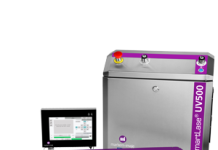This feature appears in the Africa Print Journal.
Litho printing is one of the few printing processes that is used as both an art form and commercially, with machine minders still having a sense of pride in the quality of the print that they produce; man and machine working in harmony to produce high quality print output. A good litho machine will produce good print quality; however an experienced and proud machine minder will be able to produce excellent print quality with the same machine and therein lies the art of printing. However, with the rise in popularity of digital printing machines, delivering excellent print quality at the press of a button, many people would say that this type of printing can no longer be considered an art form. After all, who can take pride in 'creating' an exceptional print, simply by pressing a button?
Perhaps, rather than asking if printing is still an art, we should rather examine whether digital and modern litho printing is an art, given the technological enhancements in this sphere, where minimal intervention by an operator is required to produce excellent print quality. With both digital and modern litho printing easily producing high print quality, both can still be considered an art, although the context has changed. In the past, the experience and technical ability of an operator to use the appropriate exposure levels for plates, set colour registration, adjust colour densities by eye, maintain and fix breakdowns and manage all the various other factors, made him a skilled artist. Today those previously manual settings are standard features on most digital and litho machines, requiring little or no adjustment by an operator; hence the perception that printing is no longer an art.
As true as this might be, in the new context there is a plethora of new requirements and features that make the difference between good print quality and exceptional print quality. Often, these new requirements are technologically driven through software, rather than having an operator actually do anything manually. In fact, very few print providers know their 'new generation' machines well enough to know what they can do differently to achieve even better print quality. Many new print companies, that don’t have experience on litho machines, have become accustomed to the standard output quality of digital machines and accept that it is good enough. Yet, there is so much more that can be done to impress clients, if the operator knows how to manipulate the digital machine. Litho operators have undergone formal training to make them adept at getting the best from their machines, however, there is no formal course to teach digital machine operators how to operate the machine, manipulate print quality through software changes and use colour management and colour profiles to enhance print quality.
Printing SA, previously known as PIFSA, has only recently started to offer formal digital training courses to help print providers educate machine operators; giving them the opportunity to obtain adequate knowledge on how to adjust digital presses through software manipulation in order to improve the overall print quality. Sadly, many digital printers have been around for many years, and now have a huge backlog of unskilled operators in the market without the adequate knowledge to use their digital printer to its full potential. Currently, most digital print operators have learned digital technology through trial and error, in the field experience, as well as through information or training supplied by the supplier of digital equipment.
The art of digital or modern day litho printing is found in how well colour is managed, colour profiles are manipulated with specific intent, along with having an in-depth knowledge of the software features on the RIP (raster image processor) and the influences they have on the output quality, as well as an understanding of the technical features and capabilities of the machine. Even technical manipulation on the machine is done via the touch panel or software. Thus, it is safe to say that the art of printing has moved from a unique mechanical or technical ability to the understanding and use of software to drive up the level of print quality.





















